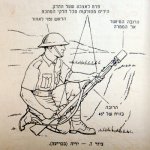From Ian Phillips, in Facebook page WORLD WAR PICTURES.
During WW2 the British Ministry of Information commissioned a series of "Birth of..." photo essays which were designed to keep the public informed of the progress of the ongoing homefront war effort.
I have previously featured the "Birth of a tank" and "Birth of a field gun" on this page.
Today it's the "Birth of a bomber".
The bomber in question is the Handley-Page Halifax, one of the RAF's principal four-engined "heavies" which, along with the Avro Lancaster and Short Stirling, carried the war to Germany.
These images were taken at the Handley-Page factory in the London suburb of Cricklewood, circa 1942.
They illustrate the various stages in the construction of these aircraft, in this case Mk IIs with the improved nose turret arrangement.
Sheet metal work...wind-tunnel tests...general assembly processes...painting...inspection and testing of the completed aircraft....and even the technical drawing offices are shown.
Also significant is the male / female work-force, typical of Britain's homefront effort during WW2.
Thanks for this. I find it completely mind blowing the wartime effort to manufacture all these aircraft, trucks, ships, tanks, guns, munitions, uniforms and...and...and...
When you visit a single aircraft restoration like the Halifax in Trenton you see how incredibly complex one single aircraft is, then multiply that by tens of thousands. Remove computer drafting and CNC machines and it gets more amazing. Visit HMCS Haida in Hamilton and have a look at what went into producing her. Yet she is one of thousands of ships ranging from wooden patrol boats to battleships. All these items were designed, drawn, machined and assembled in mere months mostly by workers new at the job and in countries whose populations were a fraction of what they are now...plus most of the available labour was in uniform. Today with all our technology it takes 3 years to design and build an overpass bridge.





























































 Just following the conflict on the Italian front during WWl on an Amazon series. It was a nasty struggle fought at close quarters and mostly vertically. Towards the end, Italians surrendered en masse, because they regarded it as futile and their stupid generals wouldn't recognize it.
Just following the conflict on the Italian front during WWl on an Amazon series. It was a nasty struggle fought at close quarters and mostly vertically. Towards the end, Italians surrendered en masse, because they regarded it as futile and their stupid generals wouldn't recognize it. 














































